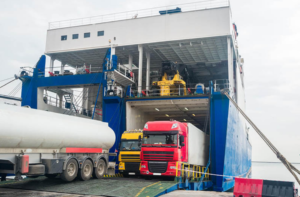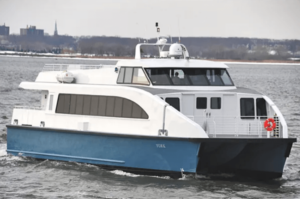Maritime Transport
Maritime transport is the process of transporting goods by sea. This process includes the travel of ships between ports, loading and unloading of cargo onto and off the ships. Maritime transport can be slower compared to other modes of transport, but it has a higher capacity for carrying more goods. Additionally, maritime transport experiences less traffic problems compared to road transport.
What is Maritime Transport and How is it Done?
Despite criticisms due to its environmental impacts, maritime transport is an important transportation method worldwide. Efficient management of ports, ships, cargoes, and all logistics processes is crucial for the success of maritime transport.
Types of Maritime Transport
-
Container Shipping:

This type of transportation is carried out using standardized containers of various sizes, which are fully adapted to fit in the cargo areas of ships. Container shipping is one of the most common methods of maritime transport worldwide and is a highly secure and efficient option for transporting cargo.
-
Roll-On/Roll-Off Shipping:

Ro-Ro transportation, also known as Roll-On/Roll-Off shipping, involves loading and unloading cargoes onto and off ships using vehicles or other transport equipment. This method is a popular option for vehicle transportation and enables quick and easy transportation of cargoes.
-
Tanker Shipping:

This type of transportation is used for the transportation of petroleum, natural gas, chemicals, and other liquid cargoes. These cargoes are carried in specially designed tanker ships and tanker shipping is a critical transportation method for the international energy sector.
-
Shipping Dry Cargo:

Dry cargo shipping is typically used for the transportation of large-volume and heavy cargoes. In this type of shipping, cargoes are loaded and unloaded directly into the cargo holds of the ship without the use of containers or other transport vehicles.
-
Passenger Transport:

This type of transportation involves people traveling by ships. Passenger ships are used for various purposes worldwide such as tourist travel, ship tours, cruise vacations, and ferry services.
The types of sea transportation may vary depending on the way the goods are transported, the size of the ships, the equipment and facilities at ports, and other factors. The transportation sector is constantly evolving, and innovations are being made to integrate and harmonize different types of sea transportation.
What Are the Types of Cargo in Maritime Transport?
Maritime transport is a type of transportation that carries goods and products via ships and vessels across the sea. It is an essential mode of transportation for international trade and commerce. The types of cargo that can be transported through maritime transport include:
- Containerized Cargo: This type of cargo includes goods and products that are transported in containers. Containers are standardized and can be easily loaded and unloaded onto ships, making them an efficient way of transporting cargo.
- Bulk Cargo: Bulk cargo refers to goods that are not packaged and are transported in large quantities. Examples of bulk cargo include grain, coal, ore, and petroleum products.
- Ro-Ro Cargo: Ro-Ro cargo refers to cargo that is transported using Roll-on/Roll-off vessels. These vessels allow cargo to be easily loaded and unloaded on wheels, such as cars and trucks.
- Breakbulk Cargo: Breakbulk cargo refers to cargo that is not containerized or bulk, such as heavy machinery or large equipment. This type of cargo requires specialized handling and is typically transported on specialized vessels.
- Liquid Cargo: Liquid cargo includes products that are transported in tankers, such as oil, gas, and chemicals.
Each type of cargo has its unique requirements and specifications for transportation, including the type of vessel used, the packaging or handling needed, and the loading and unloading process.
What is the advantages of maritime transport?
Maritime transport offers several advantages, including:
- Cost-effective: Maritime transport is generally considered to be more cost-effective than other modes of transportation, especially for long distances and large volumes of goods.
- Eco-friendly: Maritime transport has a lower carbon footprint than other modes of transportation, such as air or road transport. It is considered to be one of the most environmentally friendly modes of transportation.
- Efficient: Maritime transport can carry large volumes of goods in one shipment, which makes it more efficient than other modes of transportation. It is particularly effective for bulky or heavy goods.
- Reliable: Maritime transport schedules are generally more predictable than other modes of transportation, such as air or road transport. This makes it easier for companies to plan their supply chain and manage their inventory.
- Access to global markets: Maritime transport offers access to global markets, allowing companies to expand their customer base and increase their revenue. It also enables the movement of goods between different regions and countries, facilitating international trade.
Security Measures in the Maritime Transport
Maritime transport involves a range of security measures to ensure the safety of the crew, passengers, and cargo on board. Some of these measures include:
- International Ship and Port Facility Security (ISPS) Code: The ISPS Code was developed by the International Maritime Organization (IMO) to establish minimum security requirements for ships and port facilities. It requires ships to have a Ship Security Plan (SSP) and port facilities to have a Port Facility Security Plan (PFSP) to ensure that security risks are identified, assessed, and mitigated.
- Cargo Screening: All cargo that is loaded onto a ship must be screened for security threats before being allowed on board. This includes X-ray screening, physical inspections, and the use of sniffer dogs.
- Access Control: Access to ships and port facilities is restricted to authorized personnel only. This includes background checks for employees, crew, and visitors, as well as the use of security cameras, fencing, and security guards.
- Emergency Preparedness: Ships and port facilities are required to have emergency response plans in place to respond to security incidents, such as piracy, terrorism, or other threats. Crew members are trained in emergency response procedures and drills are conducted regularly.
- International Cooperation: International cooperation is key to ensuring the security of maritime transport. The IMO works with governments, industry organizations, and other stakeholders to share information, develop best practices, and coordinate responses to security threats.
Overall, these security measures help to ensure that maritime transport remains a safe and secure mode of transportation for people and goods around the world.
Maritime Transport Costs
Maritime transport costs can vary depending on a number of factors such as the distance of the journey, the type and size of the vessel being used, the nature and quantity of the cargo being transported, the fuel prices, port fees, and any additional services required such as loading and unloading. However, compared to other modes of transport such as air or road, maritime transport is generally considered to be a cost-effective option for transporting large volumes of goods over long distances.
- Distance: The distance between the ports of origin and destination can significantly impact the cost of maritime transport. Longer distances require more fuel, crew, and maintenance, which can increase the overall cost.
- Cargo type: The type of cargo being transported can also affect the cost. For example, hazardous or fragile cargo may require special handling and storage, which can increase the cost.
- Shipping route: The shipping route taken by the vessel can impact the cost of maritime transport. Routes that are more direct or have more frequent service may be more expensive than longer or less frequently serviced routes.
- Vessel size and type: The size and type of vessel used for the transport can also impact the cost. Larger vessels may require more crew and fuel, but can also transport more cargo, which can reduce the cost per unit. Additionally, specialized vessels, such as those designed for refrigerated cargo, may also have higher costs.
- Port fees: Port fees, including those for loading and unloading cargo, can also add to the cost of maritime transport. These fees can vary depending on the port location and the services provided.
- Insurance and security costs: Insurance and security costs can also impact the overall cost of maritime transport. Vessels may require specialized insurance coverage, and additional security measures may be necessary for certain types of cargo or routes.
- Currency exchange rates: Since maritime transport involves international trade, fluctuations in currency exchange rates can also affect the cost. A weaker currency can make exports cheaper, while a stronger currency can make imports more expensive.
Overall, the cost of maritime transport can be influenced by a variety of factors, and it’s important for shippers to carefully consider these factors when planning their transport logistics.
What equipments are used in Maritime Transport
Maritime transport involves the use of various types of equipment to ensure the safe and efficient transportation of goods and passengers. Here are some examples of equipment used in maritime transport:
- Ships and vessels: These are the primary equipment used in maritime transport. They come in different types and sizes, from small fishing boats to large cargo ships and cruise liners.
- Cranes: Cranes are used to load and unload cargo from ships. They can be located at ports or on the ships themselves, and come in various sizes and capacities.
- Containers: Containers are used to store and transport cargo on ships. They come in standard sizes and can be loaded onto ships with specialized container-handling equipment.
- Barges: Barges are flat-bottomed boats that are used to transport cargo on rivers and canals, and can be towed by tugs.
- Tugs: Tugs are small, powerful boats that are used to maneuver larger ships in ports and harbors.
- Navigation and communication equipment: This includes radar systems, GPS, radios, and other equipment used to navigate ships and communicate with other vessels and shore facilities.
- Safety equipment: Lifeboats, life jackets, fire extinguishers, and other safety equipment are essential for ensuring the safety of passengers and crew.
- Maintenance and repair equipment: This includes tools, spare parts, and equipment used to maintain and repair ships while at sea or in port.
Overall, the use of advanced equipment and technology is crucial to the safe and efficient operation of maritime transport.
What is the Main Challenges in Maritime Transport?
There are several challenges that the maritime transport industry faces. Some of the main challenges include:
- Environmental concerns: The maritime industry is under pressure to reduce its environmental impact, particularly in terms of emissions. There are increasingly strict regulations on emissions, and the industry is also exploring new technologies and fuels to reduce its carbon footprint.
- Piracy and security risks: Maritime transport faces the ongoing threat of piracy and other security risks, particularly in certain regions of the world. This can impact the safety of crews and the security of cargo, as well as increase insurance costs.
- Geopolitical issues: The maritime industry can be impacted by political instability and conflicts, which can lead to disruptions in trade routes, increased costs, and risks to the safety of vessels and crews.
- Infrastructure challenges: Port infrastructure and facilities can be a bottleneck in the supply chain, and many ports are struggling to keep up with increasing volumes of cargo. This can lead to delays, increased costs, and inefficiencies.
- Technological changes: Like many industries, the maritime industry is undergoing rapid technological change, with new innovations in automation, digitalization, and connectivity. While these changes offer many opportunities for increased efficiency and cost savings, they also bring challenges in terms of adapting to new technologies and investing in the necessary infrastructure and skills.
- Cybersecurity threats: As ships and ports become increasingly digitized, the risk of cyber attacks on maritime infrastructure is growing. This can lead to disruptions in operations and compromise the safety and security of vessels and cargo.
Efficiency and Cost Savings in Maritime Transport
Efficiency and cost savings are important factors in maritime transport as they can significantly impact the profitability and competitiveness of shipping companies. Some ways that efficiency and cost savings can be achieved in maritime transport include:
- Fuel-efficient ships: Newer ships are designed to be more fuel-efficient, which can significantly reduce operating costs. Advances in technology have led to the development of more efficient engines and the use of alternative fuels such as LNG (liquefied natural gas).
- Improved port operations: Reducing the time ships spend in port can increase efficiency and reduce costs. This can be achieved through better coordination between the ship and the port, as well as improvements in cargo handling equipment and processes.
- Route optimization: Shipping companies can save on fuel and operating costs by optimizing their routes. This involves analyzing factors such as weather conditions, traffic congestion, and fuel prices to determine the most efficient route for each voyage.
- Automation and digitization: The use of automation and digitization can reduce labor costs and improve efficiency. For example, automated cargo handling systems can reduce the time it takes to load and unload ships, while digital platforms can streamline communication and documentation processes.
- Capacity utilization: Maximizing the use of cargo space on ships can improve efficiency and reduce costs. This can be achieved through better cargo planning and management, as well as the use of larger and more efficient ships.
Mansour Logistics is always with you for the most affordable transport services.
Best Ports and Ro-Ro Routes for Maritime Transport
Best Ports:
- Singapore Port: Singapore Port is one of the busiest ports in the world and considered one of the most important ports in the Asia-Pacific region. It is considered an ideal port for container transportation.
- Rotterdam Port: Rotterdam Port is the busiest port in Europe with an annual container transportation volume of about 12 million TEUs. It also plays an important role in the transportation of other cargoes such as oil and gas.
- Shanghai Port: Shanghai Port is one of the largest ports in the world and has an annual container transportation volume of about 35 million TEUs. Compared to other ports in the Asia-Pacific region, Shanghai Port offers lower costs.
- Dubai Port: Dubai Port is the largest port in the Middle East and has an annual container transportation volume of about 15 million TEUs. Dubai Port is a hub for important trade routes worldwide.
- Hamburg Port: Hamburg Port is the largest port in Germany and has an annual container transportation volume of about 10 million TEUs. It also plays an important role in the transportation of automobiles, chemicals, and other cargoes.
Best Ro-Ro Routes:
- Scandinavia – Germany: Ro-Ro routes between Scandinavia and Germany are located on the Baltic Sea. These routes provide a fast, efficient, and safe connection between Germany’s Kiel Port and ports in Scandinavia.
- North America – Europe: Ro-Ro routes between North America and Europe largely travel over the Atlantic Ocean. These routes serve ports in the United States, such as New York, Norfolk, Baltimore, and Philadelphia, as well as ports in European countries like England, France, Belgium, Spain, and Italy.
- Turkey – Italy: Ro-Ro routes between Turkey and Italy pass over the Mediterranean. These routes serve many destinations, including Trieste, Ancona, Ravenna, Venice, and Bari in Italy, from Istanbul, Mersin, and Izmir in Turkey.
- Japan – China: Ro-Ro routes between Japan and China travel between Japan’s Nagoya, Yokohama, and Kobe ports and China’s Tianjin, Dalian, and Qingdao ports. These routes support trade between China and Japan.
- Australia – New Zealand: Ro-Ro routes between Australia and New Zealand pass over the Tasman Sea. These routes serve many destinations, including Auckland and Christchurch, from Brisbane, Sydney, and Melbourne.
- Ro-Ro routes enable effective transportation by linking many ports together. These routes reduce transportation costs between ports while also saving time. However, regardless of which route is used, safety and efficiency should always be a priority.
